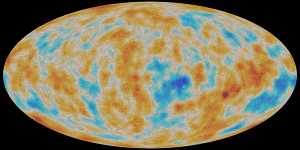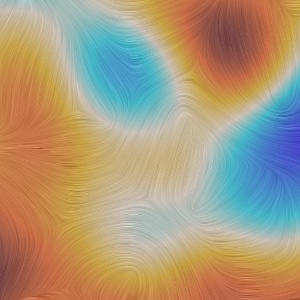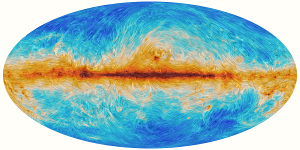 |
|
Fig. 1:
A visualisation of the polarisation of the Cosmic Microwave Background,
or CMB, as detected by ESA's Planck satellite over the entire sky. A small
fraction of the CMB is polarised - it vibrates in a preferred direction. In
this
image, the colour scale represents temperature differences in the CMB, while
the
texture indicates the direction of the polarised light. The patterns seen in
the
texture are characteristic of "E-mode" polarisation, which is the dominant type
for the CMB.
Credits: ESA and the Planck Collaboration
|
 |
 |
|
Fig. 2:
Detailed view of the polarisation map from Fig. 1, across a small patch
of the sky measuring 5º across.
Credits: ESA and the Planck Collaboration
|
 |
 |
|
Fig. 3:
The interaction between interstellar dust in the Milky Way and the structure of
our Galaxy's magnetic field, as detected by ESAs Planck satellite over the
entire sky.
Planck scanned the sky to detect the most ancient light in the history of the
Universe - the cosmic microwave background. It also detected significant
foreground emission from diffuse material in our Galaxy which, although a
nuisance for cosmological studies, is extremely important for studying the
birth
of stars and other phenomena in the Milky Way.
Interstellar clouds of gas and dust are threaded by the Galaxy's magnetic
field,
and dust grains tend to align their longest axis at right angles to the
direction of the field. As a result, the light emitted by dust grains is partly
"polarised" - it vibrates in a preferred direction and, as such, could be
caught by the polarisation-sensitive detectors on Planck. Scientists at MPA and
in the Planck collaboration are using the polarised emission of interstellar
dust to reconstruct the Galaxy's magnetic field and study its role in the
build-up of structure in the Milky Way, leading to star formation.
Credits: ESA and the Planck Collaboration
|
|  |
The history of our Universe began 13.8 billion years ago and for researchers
trying to understand its evolution, one major source of information is the
Cosmic Microwave Background, or CMB. This fossil light is resulting from a time
when the Universe was hot and dense, only 380 000 years after the Big Bang.
Thanks to the expansion of the Universe, we see this light today covering the
whole sky at microwave wavelengths.
Between 2009 and 2013, Planck surveyed the sky to study this ancient light in
unprecedented detail. Tiny differences in the backgrounds temperature trace
regions of slightly different density in the early cosmos, representing the
seeds of all future structure, the stars and galaxies of today. Scientists from
the Planck collaboration have published the results from the analysis of these
data in numerous scientific papers over the past two years, confirming the
standard cosmological picture of our Universe with ever greater accuracy (see
e.g.  here). here).
"The detailed map of CMB temperature structures is one of the key scientific
results of the 21st century," explains Simon White, director at the Max Planck
Institute for Astrophysics and Co-Investigator of Planck. "It is a
high-fidelity
image of the boundary of our visible Universe, showing us its detailed
structure
when it was 40,000 times younger than today and giving us our best indication
of
what happened at even earlier times."
"But there is more: the CMB carries additional clues about our cosmic history
that are encoded in its 'polarisation'," explains Jan Tauber, ESA's Planck
project scientist. "Planck has measured this signal for the first time at high
resolution over the entire sky, producing the unique maps released today."
Light is polarised when it vibrates in a preferred direction, something that
may
arise as a result of photons - the particles of light - bouncing off other
particles, such as electrons. This is exactly what happened when the CMB
originated in the early Universe. Planck's polarisation data provide an
independent way to measure cosmological parameters and thus confirm the details
of the standard cosmological picture determined from CMB temperature
fluctuations.
However, as the CMB light travelled through space and time it was also
influenced by the first stars and the polarisation data now indicates that
these started to shine about 550 million years after the Big Bang, ending the
"Dark Ages". This is more than 100 million years later than previously thought
but actually helps to resolve a problem: Previous studies of the CMB
polarisation seemed to point towards an earlier dawn of the first stars, while
very deep images of the sky indicated that the earliest known galaxies in the
Universe (forming perhaps 300-400 million years after the Big Bang) would not
have been powerful enough to succeed at ending the Dark Ages within 450 million
years. The new evidence from Planck significantly reduces the problem,
indicating that the earliest stars and galaxies alone might have been enough.
But the first stars are definitely not the whole story. With the new Planck
data
released today, scientists are also studying the polarisation of foreground
emission from gas and dust in the Milky Way to analyse the structure of the
Galactic magnetic field.
"With its nine frequency channels, Planck is uniquely suited to disentangle the
cosmological signal from foreground emission - but we have to be very careful
in
analysing the data," explains Torsten Enßlin, leader of the Planck technical
team at the Max Planck Institute for Astrophysics. "Our results show that the
polarised emission from dust in our Milky Way is significant over the entire
sky, dashing earlier hopes that some areas might be clean enough to offer an
uncontaminated view of the early universe. The polarised emission beautifully
traces Galactic magnetic fields and provides unprecedented insights into the
complex weather phenomena of our Milky Way."
The new data have also enabled important insights into the early cosmos and the
nature of its components, including the intriguing dark matter and the elusive
neutrinos, as described in papers also released today. The Planck data have
delved into the even earlier history of the cosmos, all the way to inflation
the brief era of accelerated expansion that the Universe underwent when it was
a
tiny fraction of a second old. As the ultimate probe of this epoch, astronomers
are currently looking for a signature of gravitational waves triggered by
inflation and later imprinted on the polarisation of the CMB.
Earlier claims of a direct detection had to be revised in light of Plancks
maps
of dust polarisation, as  reported last week. Combining
the newest Planck data
with the latest results from other experiments, the limits on the amount of
primordial gravitational waves have been pushed down, producing upper limits
that already exclude some models for inflation. reported last week. Combining
the newest Planck data
with the latest results from other experiments, the limits on the amount of
primordial gravitational waves have been pushed down, producing upper limits
that already exclude some models for inflation.
Notes for Editors
A series of scientific papers describing the new results was published on 5
February. They can be downloaded  here. here.
The new results from Planck are based on the complete surveys of the complete
sky, performed between 2009 and 2013. New data, including temperature maps of
the CMB at all nine frequencies observed by Planck and polarisation maps at
four
frequencies (30, 44, 70 and 353 GHz), are also released today.
More about Planck
Launched in 2009, Planck was designed to map the sky in nine frequencies using
two state-of-the-art instruments: the Low Frequency Instrument, which includes
three frequency bands in the range 3070 GHz, and the High Frequency
Instrument,
which includes six frequency bands in the range 100857 GHz.
HFI completed its survey in January 2012, while LFI continued to make science
observations until 3 October 2013, before being switched off on 19 October
2013.
Seven of Planck's nine frequency channels were equipped with
polarisation-sensitive detectors.
The Planck Scientific Collaboration consists of all the scientists who have
contributed to the development of the mission, and who participate in the
scientific exploitation of the data during the proprietary period.
These scientists are members of one or more of four consortia: the LFI
Consortium, the HFI Consortium, the DK-Planck Consortium, and ESAs Planck
Science Office. The two European-led Planck Data Processing Centres are located
in Paris, France and Trieste, Italy.
The LFI consortium is led by N. Mandolesi, Università degli Studi di Ferrara,
Italy (deputy PI: M. Bersanelli, Università degli Studi di Milano, Italy), and
was responsible for the development and operation of LFI. The HFI consortium is
led by J.L. Puget, Institut d'Astrophysique Spatiale in Orsay, France (deputy
PI: F. Bouchet, Institut d'Astrophysique de Paris, France), and was responsible
for the development and operation of HFI.
For further information, please contact:
Prof. Simon White
Director
Max-Planck-Institut für Astrophysik
Tel: +49 89 30000-2211
E-mail: swhite mpa-garching.mpg.de mpa-garching.mpg.de
Dr. Torsten Enßlin
Max-Planck-Institut für Astrophysik
Tel.: +49 89 30000-2243
email: tensslin mpa-garching.mpg.de mpa-garching.mpg.de
Dr. Hannelore Hämmerle
Press Officer
Max-Planck-Institut für Astrophysik
Tel. +49 89 30000-3980
E-mail: pr mpa-garching.mpg.de mpa-garching.mpg.de
Links:
Full ESA Press Release:  Planck reveals first stars were born late Planck reveals first stars were born late
Scientific Papers describing the  new results. new results.
|



 mpa-garching.mpg.de
mpa-garching.mpg.de